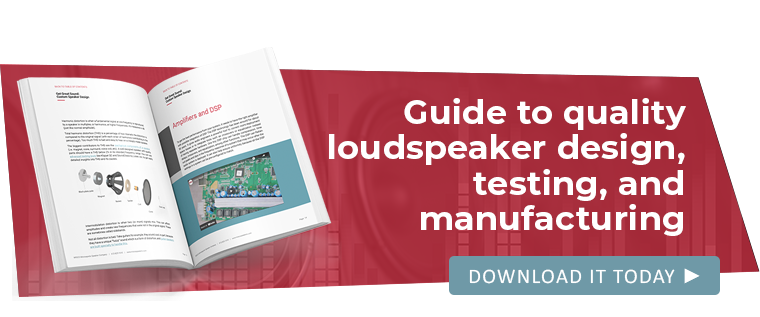OEM Speaker Design: Design Considerations [VIDEO]
To work best with a loudspeaker manufacturer and arrive at an audio system that meets your needs and is within your budget you will start by providing some basic usage information. That means being ready to answer (or discuss) these questions.
- What type of speaker is needed?
- What will your speaker system be doing?
- How loud will you need it to be?
- How much space do you have for the speakers and other components?
- Will your system be competing with other sounds when it is in use?
- How will you power your speakers?
- Are there other factors that need to be considered? (e.g. waterproof, extreme ruggedness, extreme temperatures, zero gravity?)
- What is the per-unit budget?
Don’t worry if you don’t already know the exact decibel (dB) level you’re going to need from your speakers. A good speaker manufacturer can help translate layman’s answers into specifics around things like size constraints, impedance, and power rating.
Resource: Speaker Specs 101
Designing and Building a Loudspeaker Video Series
To help our customers better understand the process and what goes into designing and building a speaker, MISCO has created a unique, five-part video series that gives a behind-the-scenes view of the processes that go into designing, building, and testing a loudspeaker. The questions listed above are the types of questions that your speaker manufacturer will ask to get the ball rolling and set limits on the roadmap that’ll be used to arrive at a final product. This information gathering phase of speaker design is extremely important because it will save you time and money down the road. Make sure the speaker company you work with listens to your needs, understands them, and asks good questions.
The first video in the five-part series shows you how a loudspeaker manufacturer, like MISCO, approaches the speaker design process for their customers.
Starting the Design Process
Speaker manufacturers keep an archive of the prototypes and designs they’ve created in the past. A new project generally goes best when it begins by iterating off one of these already functioning products (MISCO has over seven decades of archived designs to tap into).
If an existing speaker needs to be modified (or a new one created altogether), engineers use CAD software to make the technical drawings. These drawings are then converted into STL (Standard Tessellation Language) files and then into G-code files for 3D printing.
By utilizing 3D printing, product development teams have the ability to swiftly create prototypes of novel parts and components. With this technology, engineers can assess their effectiveness with precision prior to full production.
By delicately manipulating the thermoplastic materials and filaments used in the 3D printing process, product engineers can shape both mechanical and physical components that influence sound resonance. This frees people up to consider aesthetically pleasing or custom-fitted contours, without sacrificing superior sound quality produced by traditional "wood box" shaped speaker enclosures.
Tuning Speaker Enclosures
The enclosure that a speaker is housed in will always impact the sound in some way. Every enclosure will have a specific resonant frequency. Speaker manufacturers can help customers figure out if their systems will benefit from ported enclosures, which allow speakers to be louder and handle lower frequencies better than they could in a comparable sealed enclosure. MISCO has even perfected proprietary dual-ported enclosure designs that help very small speakers sound very big and impressive without the space restrictions.
The speaker designed in the video above has an enclosure with an internal volume of about 320 cubic inches (5.25 liters). The woofer used has a resonant frequency of about 80 Hertz. However, the engineers working on the project added a port to tune the enclosure to, roughly, 65 hertz. Because engineers could match the driver and the ported enclosure together, they’re able to create a speaker that delivers a nice smooth response, using a little bit higher Q driver than might be traditionally considered.
Resource: Audio Acronyms for Speaker Design
Powering Your Speakers
Will you need passive speakers or a powered system? Make sure you talk about this with your speaker manufacturer in the initial conversation. If you do need a full system, you will likely get better results by working with the same company for both the speakers and an amplifier. You can use Digital Signal Processing (DSP) in today’s Class-D amplifiers to dramatically improve the performance of a system when it is designed with the amp, speakers, and enclosures all in mind at the same time.
Testing Your System
The scientific design tools available to transducer engineers these days are very powerful. However, because there is an art to speaker design, it is important that a speaker prototype is tested to ensure it meets the initial requirements set out by the customer.
One of the best tools in the world for testing speakers is the Klippel Near Field Scanner. It is an autonomous robot that can be programmed to measure how a speaker will sound in the real world. A speaker is placed on the scanner, the software is programmed, and the robot takes over, making hundreds, even thousands of audio measurements in a full sphere around the device. After the scan, you will be left with a comprehensive representation that depicts how sound is dispersed from the speaker in all directions.
The video in this blog is the first in a series that will explore MISCO’s approach to OEM speaker production. If you have any questions about our process, please reach out to our team.

